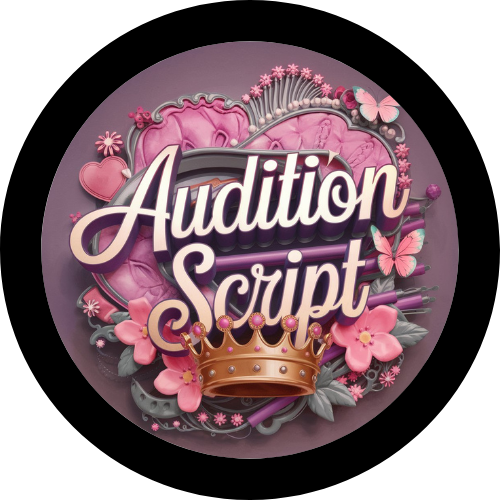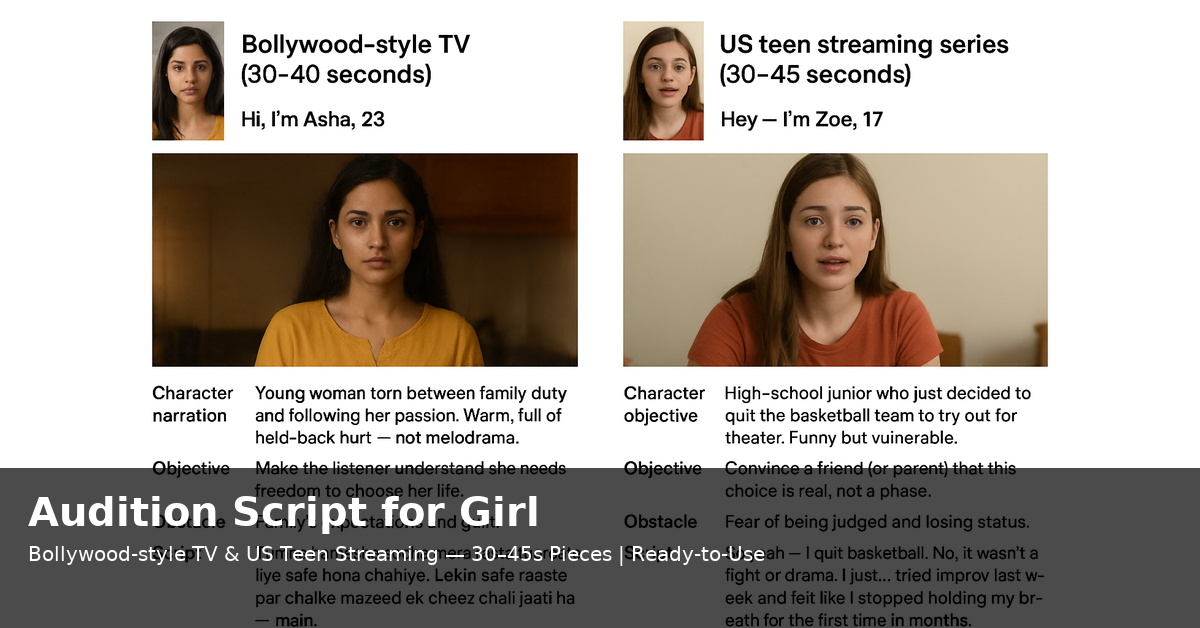Audition Script for Girl — Practical, Ready-to-Use Pieces
Looking for short, truthful, and usable audition scripts for a girl’s audition — whether it’s for film, TV, theatre, or a commercial in India or the United States? Below are clear guidelines, performance tips, and real, ready-to-record examples you can use right away. Each example includes character notes and suggested length, so you know what casting directors expect.
How to pick the right audition piece
- Match the age and type: Select a script that sounds like the age you can convincingly play (8–12, teen, young adult). Casting cares more about believability than your actual birth year.
- Tone & genre: If the audition calls for drama, don’t bring comedy. If it’s a self-tape for a youth commercial, keep it bright and simple.
- Length: 30–90 seconds is typical for monologues; 10–30 seconds for commercials. For self-tapes, follow the casting directions — if none are given, 60 seconds is a safe maximum.
- Language & cultural references: For India and the US audiences, avoid very local slang unless requested. Universally truthful emotions travel best across cultures.
Quick self-tape checklist (remote auditions)
- Natural, quiet background; no distractions.
- Camera at eye level; frame from mid-chest up for monologues.
- Good lighting (face visible, avoid strong backlight).
- Slate quickly (name, age, role), then perform.
- Say the audition title or scene name if asked. Keep file format and naming as instructed.
Performance tips (human, not robotic)
- Find the moment: What changed in the character’s life right before this scene? Anchor your choices there.
- Make choices but stay flexible: Pick a feeling and justify every line. If direction changes, be ready to alter volume, pace, or eye-line.
- Use beats: Pause where the character breathes or thinks — it makes the performance realistic.
- Avoid “acting” the words: Instead, react honestly to the imagined partner or situation.
- Warm up voice and face: Say a line, then immediately act like the character would respond to it.
Real Examples — Ready to Use
Below are four fully written pieces — a commercial, a dramatic monologue, a comedic monologue, and a short child piece. Each is labeled with character notes and suggested time.
Example 1 — Short Commercial (20–25 seconds)
Role: Teen girl (15–18) — confident, relatable.
Product: Energy drink / youth beverage.
Direction: Bright, energetic; one camera, direct to camera; natural smile at the end.
Script
SLATE: “Hi — I’m Aisha, 16.”
(Beat — smile, look directly at camera)
“Tests, practice, and a million to-dos — my day never stops. But one sip of Spark Up and I don’t just get through the day, I crush it. Focus, energy, zero weird aftertaste. Spark Up go do that thing you’ve been putting off.”
(Wink, small laugh, exit look at phone)
Why this works: Short, conversational, believable for both Indian and US teen audiences. Easy to tweak for local product names.
Example 2 — Dramatic Monologue (60–90 seconds)
Role: Young woman (late teens/early 20s) dealing with family pressure. Emotional, but held; not melodramatic.
Character note: She’s tired of being told what to do but loves her family — conflict comes from care, not hatred.
Script
(She sits on a small stool, hands clasped. She speaks slowly, each sentence measured.)
“You think I don’t know what I’m doing? You say ‘safe’, ‘practical’, ‘stable’—like those words are a warm blanket. But they feel like a cage when it’s not my hand holding the bars.
I failed one exam and suddenly everyone’s plans were rewritten — for me. Not with me. I dream about design, about colors that don’t match what you’d pick, about a tiny studio with half-painted walls.
I’m not asking you to leave the road you chose. I’m asking — just once — to let me choose my street. If I fall, I’ll learn to get up. I’ll fall with my own footprints to follow.”
(A pause. Softer.) “Please. Let me learn the shape of my own life.”
Why this works: Universal theme (family vs. independence) resonates with both Indian and US casting directors. Natural rhythm, emotional truth, no clichés.
Example 3 — Comedic Monologue (45–60 seconds)
Role: Young adult (20s) auditioning for a sitcom scene. Wry, quick delivery.
Direction: Aim for specificity; pause for implied punchlines.
Script
(Talking into a phone, mock exasperation.)
“Mom called me three times today. Three. I answered once and she asked if I’d eaten. Then she asked if I’d slept. Then she asked if I’d packed an umbrella even though the forecast said ‘sunny.’
I love you, Mom. I do. But if she keeps insisting, I carry an umbrella on a sunny day, I’m starting a petition: ‘For the right to get mildly wet without international concern.’
(Beat.) Also — apparently ‘mildly wet’ is a health hazard according to my mother.”
(Smile, beat, deliver final line with playful surrender.) “Okay, mom, I’ll carry an umbrella.”
Why this works: Short, punchy, relatable humor for multi-cultural audiences; physical beats can be added for a stronger comedic rhythm.
Example 4 — Child Piece (8–12 years) — Emotional, Short (30–40 seconds)
Role: Young girl missing her grandmother (fits India & US family-driven stories). Simple and honest.
Direction: Soft, clear, no forced crying — think small, real gestures (playing with fingers, looking at a photo).
Script
(Holding a small torn photograph)
“Dadi used to make the best halwa. She would hum and the whole kitchen would smell like sugar and spice. Now it’s quiet. I tried to make halwa like her. It turned into…kinda chewy rocks.
I miss her stories about the moon being made of silver. I miss her telling me, ‘It will be okay, beta.’ I think I’m starting to believe her… but only when I close my eyes.”
(A tiny smile, brave.)
Why this works: Simple, specific imagery, and a small, truthful emotional core. Casting likes honesty from child actors.
Some More for Practice
1) Bollywood-style TV (30–40 seconds)
SLATE: “Hi, I’m Asha, 23.”
Character: Young woman torn between family duty and following her passion. Warm, full of held-back hurt — not melodrama.
Objective: Make the listener understand she needs freedom to choose her life.
Obstacle: Family’s expectations and guilt.
Script:
(She stands in a dim kitchen, voice steady but trembling.)
“Tumne hamesha socha mera rasta tumhare liye safe hona chahiye. Lekin safe raaste par chalke mazeed ek cheez chali jaati hai — main.
Main medical nahi banna chahti kyunki everyone says it’s ‘secure’. Main art se jeena chahti hoon. Main apni zindagi khud chunungi. (I will choose my own life.)
Agar tumne mujhe yahin roka, toh main na sirf apni khushi kho dungi — balki khud ko bhi kho dungi.”
Performance notes: Start contained — tension builds in the second sentence. Let the Hindi line land softly, then a small, honest break before the last line. No big tears; quiet resolve.
2) US teen streaming series (30–45 seconds)
SLATE: “Hey — I’m Zoe, 17.”
Character: High-school junior who just decided to quit the basketball team to try out for theater. Funny but vulnerable.
Objective: Convince a friend (or parent) that this choice is real, not a phase.
Obstacle: Fear of being judged and losing status.
Script:
(Talking while tying shoelaces, half-laughing, half-serious.)
“So yeah — I quit basketball. No, it wasn’t a fight or drama. I just… tried improv last week and felt like I stopped holding my breath for the first time in months.
It’s weird — people expect me to keep the same script because it’s easy. But I’d rather mess up onstage than play somebody else’s life perfectly. Give me one chance to be terrible and actually happy.”
Performance notes: Use quick pacing with small laughs; drop to quieter tone on the last sentence. Make the “stop holding my breath” moment real — that’s the emotional hook.
How to Mark Up a Script for Audition (Quick Example)
Take the dramatic monologue above and mark:
- Objective: “Convince family to let her choose.”
- Obstacle: Family’s fear of instability.
- Beat 1 (0–20s): Frustration — “You think I don’t know…”
- Beat 2 (20–50s): Memory/dream — “I dream about design…”
- Beat 3 (50–end): Plea/soften — “Please. Let me learn…”
This keeps your performance grounded and helps you make clear choices on camera.
Final checklist before you hit record
- Slate clearly.
- Keep performance under requested time.
- Use simple wardrobe — neutral, not distracting.
- Don’t edit your performance to hide mistakes unless the casting says you may send a best take. One clean take is better than stitched-together pieces.
- Label the file correctly (Name_Role_Take.mp4).

